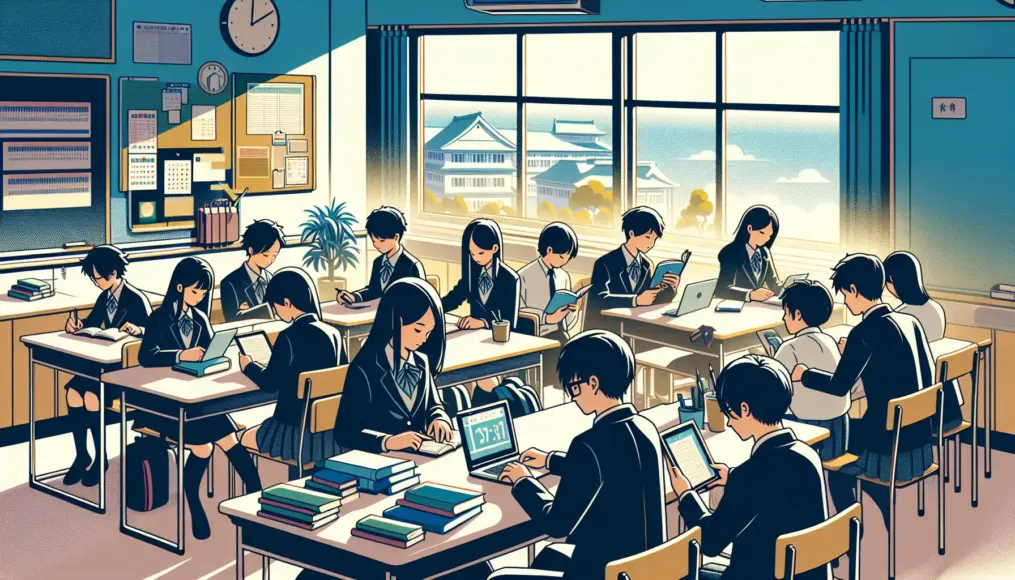The high school tuition-free policy is drawing attention as a significant step towards broadening educational opportunities for many families. This initiative arose from a desire to guarantee the right to education and to reduce the number of children who give up on pursuing their studies due to financial constraints. How exactly is this policy benefiting the youth who will shape Japan’s future?
In this article, we will delve into the historical background of the high school tuition-free policy, examine the current state of the system, and explore its impacts and future prospects. We’ll also consider how this policy promotes educational equity and its implications for the economy. We invite you to read through to the end.
- We’ll look back at the origins of the tuition-free policy and the initial reactions to it.
- We’ll provide a detailed analysis of the advantages and challenges of the current system.
- We’ll explore future policy directions and learn through international comparisons.
The Historical Background of Free High School Education in Japan
The policy of providing free high school education is a significant initiative implemented in Japan to create equal educational opportunities. At its core, this policy aims to reduce the number of children who give up on attending high school due to financial constraints. As we entered the 2010s, the burden of educational expenses began to weigh heavily on families, increasing the necessity for this policy.
In this section, we will delve into how the free high school education policy came into being, along with the reactions and challenges it faced in its early stages. Understanding the evolution of this initiative is crucial for grasping the current system.
The Beginning of the Policy
The free high school education policy was initiated in 2010. It started as a support measure to enable children from economically disadvantaged families to pursue high school education. The government aimed to realize this initiative as part of its commitment to educational equality.
Upon the policy’s introduction, many families felt hopeful. However, concerns also arose regarding securing funding and the operational aspects of the program. These challenges sparked lively discussions about the implementation of the free education initiative.
- The free high school education policy began in 2010.
- It aims to decrease the number of children who forgo education due to financial reasons.
- Issues surrounding funding and program operations emerged as concerns.
Initial Reactions and Challenges
Once the free high school education policy was put into place, reactions varied widely. While many families rejoiced at the relief it provided, anxieties about how the program would be managed also surfaced. There was a particular need for clear criteria regarding who would qualify for the program, which at times led to confusion.
Additionally, budgetary issues associated with the implementation of this policy posed a significant challenge. With demands for financial resources, the government needed to explore ways to ensure the sustainable operation of the program. By overcoming these challenges, the free education initiative gradually evolved.
- The introduction of free high school education brought both hope and anxiety for families.
- Confusion arose over the criteria for eligibility and conditions.
- Securing funding and ensuring sustainable operation were major challenges.
Current Status of High School Tuition-Free Policy
The high school tuition-free policy has undergone significant changes since its introduction a few years ago. Today, this system plays a crucial role in alleviating the financial burden for families hesitant to pursue higher education due to economic reasons. However, various challenges remain in the implementation of the policy, necessitating further improvements. In this section, we will take a closer look at the current high school tuition-free system, its benefits, and the issues it faces.
The primary goal of the high school tuition-free policy is to provide equal educational opportunities for all children. Specifically, it is designed to offer support based on family income levels. Let’s explore how this system operates and the advantages and challenges it presents.
Overview of the Current System
The current high school tuition-free policy essentially waives tuition fees for students attending public high schools. Specifically, support is provided based on household income, with particularly generous assistance for families in financial hardship. As a result, many students can now pursue their education without having to give up due to economic constraints.
On the other hand, students attending private high schools can receive subsidies, but only if they meet certain conditions. While the current system has been designed to cater to diverse needs, it is clear that there is still room for improvement.
- The current policy waives tuition fees for public high schools.
- Support is provided based on family income.
- Conditional subsidies are available for private high schools.
Advantages and Challenges of the Policy
The greatest advantage of the high school tuition-free policy is its promotion of educational equality. By reducing financial burdens, more children can advance to high school and gain valuable learning opportunities. Additionally, the recognition of the importance of education has been reinvigorated, leading to increased interest in academic pursuits.
However, several challenges still exist within the system. Issues such as securing funding for the tuition-free initiative and a lack of awareness about the policy are prominent concerns. To address these challenges, further efforts and improvements are required. It is essential to create a better environment for the children who will shape the future of education.
- The promotion of educational equality is the policy’s primary advantage.
- Financial burdens have been reduced, allowing more children to pursue higher education.
- Funding issues and lack of awareness about the policy are significant challenges.
The Impact and Achievements of Free High School Education
Since the implementation of the free high school education policy, there has been extensive discussion regarding its effects on educational equality and the economy. This initiative aims to provide every child with access to education, proving to be a significant relief for many families. However, it’s crucial to examine the actual impacts and outcomes of this policy. This section delves into how free high school education has influenced educational equality and its economic implications.
The introduction of the free high school education policy has narrowed the educational gap, allowing more students to choose the path of higher education. This change not only affects education itself but also has far-reaching economic implications for society in the future. Understanding the achievements of this policy is essential for guiding future educational initiatives.
Impact on Educational Equality
The free high school education policy has made it easier for children from economically disadvantaged families to access education. As a result, enrollment rates have improved, significantly enhancing educational equality. Various studies confirm that the rate of students from low-income households progressing to high school has risen noticeably.
Moreover, the increase in educational opportunities has led to improved academic performance. When students from diverse backgrounds learn in the same classroom, it fosters mutual understanding and creates a better learning environment. Such changes are likely to contribute to the overall development of society in the long run.
- Educational equality has improved, leading to higher enrollment rates.
- Students from low-income families now find it easier to pursue education.
- The presence of diverse students in the same classroom enhances academic performance.
Economic Impact
The free high school education policy also has significant economic ramifications. By broadening access to education, we can expect an improvement in the quality of the future workforce, contributing to economic growth. Additionally, as families experience a reduction in educational expenses, they gain the flexibility to allocate funds to other living costs, thereby stimulating consumption.
However, securing funding for this initiative remains a challenge. The government needs to find stable sources of revenue to ensure the sustainable operation of this program. Addressing these issues is essential for continuously realizing the ideals behind the free education policy.
- Expanding educational opportunities contributes to the quality of the workforce.
- Reduced educational costs for families encourage consumption.
- Securing funding remains a significant challenge.
The Future of Free High School Education
The policy of providing free high school education is expected to evolve further within our education system. Building on past achievements, it’s essential to enhance the direction of this policy and improve the system to offer more children access to educational opportunities. Additionally, learning from an international perspective is vital; by examining successful examples from other countries, we can work towards improving Japan’s educational framework. In this section, we will explore the future direction of policy and the insights gained from international comparisons.
Future initiatives for free high school education should not only focus on eliminating educational costs but also emphasize improving the curriculum and educational environment. The goal is to ensure that all children receive a high-quality education.
Future Directions for Policy
One crucial direction for the free high school education policy is to increase the system’s flexibility. For instance, expanding support based on the household’s financial situation and being considerate of students requiring special education are both necessary steps. Furthermore, enhancing support for students attending private high schools is also an important aspect.
To improve the quality of education, it is essential to invest in teacher training and review the curriculum. By aligning the free education policy with initiatives aimed at enhancing educational quality, we can expect to create a more effective learning environment. Through these efforts, the free education policy is poised to develop sustainably.
- Increasing the system’s flexibility is a key future direction
- Attention to special education is essential
- Efforts to improve educational quality are crucial
International Comparisons and Learning
Considering free high school education from an international perspective is equally important. As many countries move towards free education, we can learn valuable lessons from both their successes and failures. For example, Nordic countries not only provide free education but also offer substantial support to enhance educational quality, and the results are clearly reflected in their statistics.
Japan must look to these countries as models for improving its own educational system. Particularly, by engaging in international comparisons regarding education, we can adopt superior policies and systems from other nations, paving the way for a better future.
Gaining insights from an international perspective is crucial for the evolution of the free high school education policy. Learning from the successful experiences of other countries can provide valuable knowledge that contributes to the improvement of Japan’s educational framework. For more related articles, check out this piece on “The Economic and Social Impact of Declining Birth Rates,” which delves into how declining birth rates affect the education system and will further deepen your understanding.
- Learning from successful international examples is vital
- The initiatives of Nordic countries serve as a valuable reference
- There is hope for Japan to incorporate effective policies from other nations
Conclusion
Japan’s high school tuition-free policy is a significant initiative aimed at promoting equal educational opportunities, and it has had a profound impact on the country’s education system. This policy has led to a decrease in the number of children hesitant to pursue further education due to financial concerns, easing the financial burden on many families seeking to provide their children with quality education. Furthermore, the implementation of free tuition has created an environment where students from diverse backgrounds can learn together, ultimately enhancing the overall quality of education.
Looking ahead, it is essential to increase the flexibility of the system and draw inspiration from successful international examples to build a sustainable educational environment. It is crucial to thoroughly evaluate the impacts and outcomes of high school tuition-free policies and strive for further improvements.
- The high school tuition-free policy promotes educational equality.
- The financial burden has been alleviated, allowing more students to pursue further education.
- Learning from an international perspective will influence future policies.
High school tuition-free education is a vital pillar supporting the future of education. We would love to hear your thoughts and opinions in the comments!



Comment